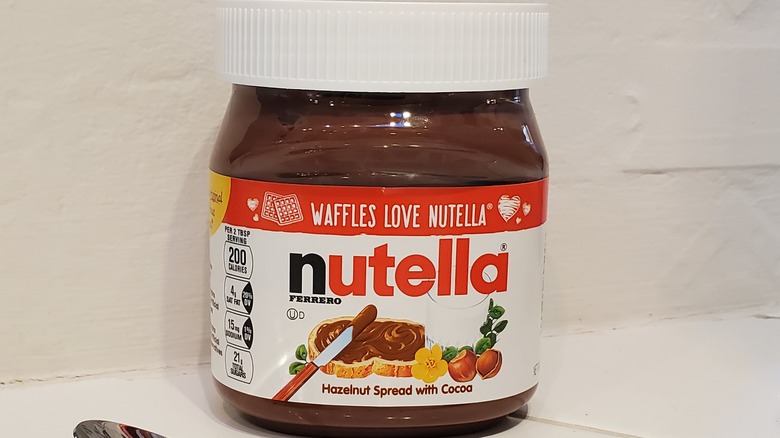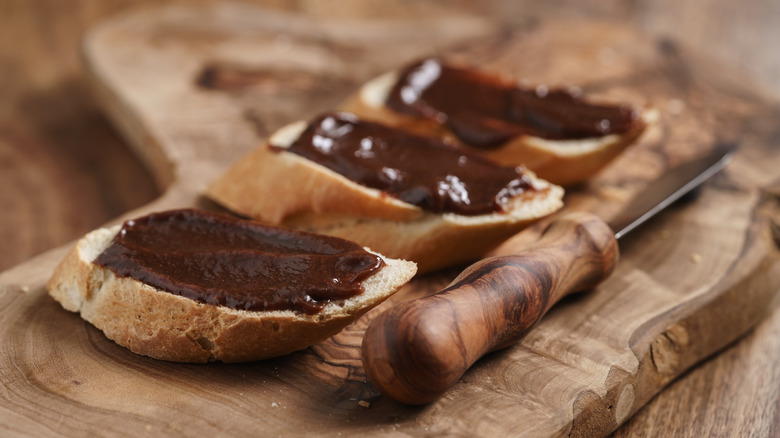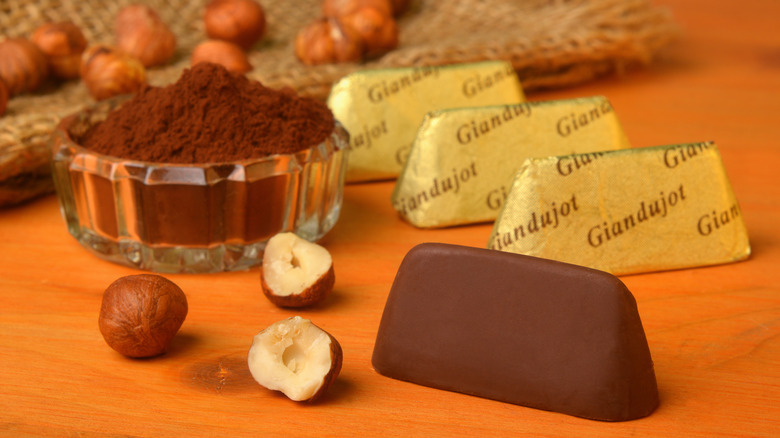Nutella Has Been Around Much Longer Than You'd Think
The thick, chocolatey spread known around the world as Nutella is quite the contemporary fascination, and frequently reenters culinary trends as part of buzz-worthy desserts, new grocery store products, and viral social media recipes. It's hard to imagine the brand's small plastic jars and brightly colored-labels outside of a modern grocery store or breakfast table, but this beloved chocolate-hazelnut spread has a long and fascinating history.
One of the things you likely didn't know about Nutella is that it was invented in Piedmont, Italy as a solution to wartime food rationing, just after the end of World War II. In 1946, as the availability of cocoa in Europe dwindled, pastry chef Pietro Ferrero created his own chocolate-hazelnut paste product, which he called Giandujot. This paste stretched out smaller quantities of expensive cocoa by combining it with nuts and sugar.It was later tweaked to become a spread called La Supercrema, and by 1961, it went through another adaptation and was first sold under the brand name Nutella.
However, the concept of Ferrero's chocolate-hazelnut paste long predates World War II, with similar products being made in the same region as far back as the early 1800s. The story of Italy's love for hazelnut paste begins before the country was even united as Italy, which happened in 1861.
Nutella's Italian origins
If you know a little bit about Italian history, it makes perfect sense that Ferrero created Nutella in the Piedmont region. While the Ferrero family says that the abundance of hazelnuts in their native town of Alba inspired modern Nutella, those same hazelnuts were already being combined with chocolate in the greater Piedmont area for generations prior to World War II.
Back in the early 1800s, the Piedmontese capital of Turin was known to produce some of the finest chocolate in Europe. Most of the cacao for that chocolate originated from Central America and the Upper Amazon Basin, where cacao trees are native, and since the British traded extensively in these chocolate-producing regions, most of Italy's cacao came through the British. But when Napoleon Bonaparte expanded the French empire to include the lands that would become Italy, things changed. The Continental System, which Napoleon implemented in 1806, cut off all trade with the British, meaning it also cut the Turinese off from their precious chocolate.
You say Nutella, I say gianduja
Legend goes that the Turin chocolatiers responded to the new Continental System by cutting their chocolate with ground hazelnuts, which were local and plentiful. Some historians rebut this theory, instead proposing that French influence from Napoleon's invasion brought the combination of chocolate and hazelnuts to Italy, but what's known for certain is that by 1865 at the latest, Turin's love of chocolate and hazelnut paste was well-known enough to earn the product a common name.
The paste became known as gianduja or gianduia, which takes its name from a Piedmontese folk hero called Gianduia. This character from commedia dell'arte (a form of Italian theatre) became popular as a local mascot during Italy's unification movement in the mid-1800s. The shape of his tricorn hat served as the inspiration for chocolate-hazelnut treats called gianduiotti, which the Italian chocolate company Caffarel claims to have invented.
Though the story of its invention is murky, gianduja's name has stuck. You now know why Pietro Ferrero's La Supercrema (and later Nutella) was originally called Giandujot. Loosely speaking, your favorite breakfast spread is more than 200 years old. You can thank the chocolatiers of Piedmont when you enjoy Nutella on toast, waffles, brownies, and whatever else your heart desires.



